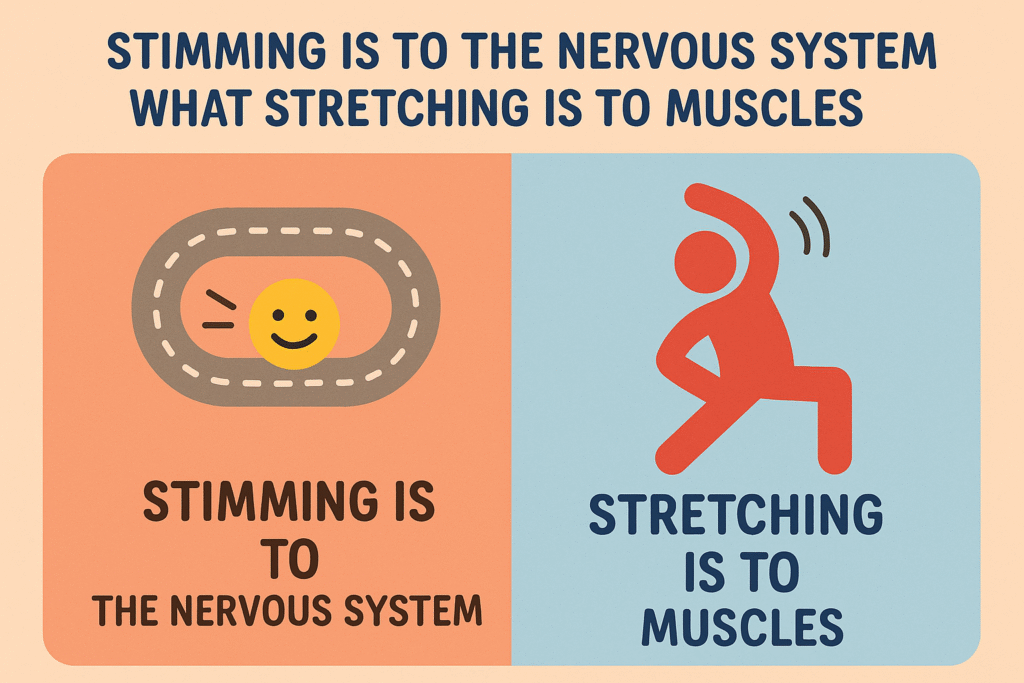It’s Not Just a Kid Thing: Adults Stim Too (We’re Just Sneakier About It)
There’s a funny thing that happens when you grow up with an invisible neurological difference. You either get really good at hiding it… or really good at apologising for it. And when it comes to stimming, those self-stimulatory behaviours that help regulate emotions, focus and sensory input – the world tends to assume it’s strictly a childhood thing.
Spoiler alert: it’s not.
Adult stimming is alive, well, and usually happening under the table, behind closed doors, or disguised as a quirky little “habit.” But make no mistake, it’s powerful, purposeful, and deserves a lot more airtime. Especially in the world of Neuro work, where appearances are everything and “looking normal” often trumps actually feeling okay.
Let’s break the silence.
So What Is Stimming in Adults?
“Stimming” is shorthand for self-stimulatory behaviour. It’s any repetitive movement, sound, or activity that helps regulate the nervous system. Think of it as the body’s pressure valve, a release system for sensory overload, anxiety, excitement, boredom, or emotional overwhelm.
In children (especially those diagnosed autistic), it’s more accepted – hand flapping, rocking, humming. But in adults? It’s expected to vanish. But it doesn’t.
Common Types of Adult Stimming:
- Hair twirling or pulling
- Tapping fingers, feet, or nails
- Chewing on pens, inside of cheeks, or shirt collars
- Pacing or walking in circles while thinking
- Repeating certain phrases or sounds (especially under stress)
- Fidgeting with rings, zips, or fabric
- Biting lips or picking skin
- Cracking knuckles or joints on loop
- Staring at lights, spinning objects, or scrolling mindlessly
Some are subtle. Others less so. And in high-pressure settings like corporate offices or romantic dates, they can draw unwanted attention.
Why Do We Stim?
Because the world is loud. And bright. And demanding. And weird. And also sometimes boring. Stimming is a body-led way of doing something when your brain is spinning, freezing or both.

For neurodivergent adults (including those with ADHD, autism, anxiety, OCD or trauma backgrounds), stimming is often essential for:
- Regulating emotions (especially under pressure)
- Focusing attention (hello, “productive fidgeting”)
- Processing information (you’d be amazed what pacing can solve)
- Soothing sensory overload (too much noise, light, smell, people…)
In short: it’s not a flaw. It’s a function.
When Stimming Meets “Neuro Work”: The Office Dilemma
Workplaces, especially the corporate kind, tend to reward a very specific flavour of stillness. Calm body language, eye contact, quiet focus. Unfortunately, Neuro work often demands exactly what our bodies struggle to suppress.
In meetings, a stimmer may:
- Doodle frantically
- Bounce their leg under the table
- Zone out to focus inward
- Mumble phrases quietly to self while trying to process thoughts
This isn’t “rudeness.” It’s regulation. But to the neurotypical eye, it can look like disrespect, boredom, or distraction.
Some neurodivergent adults learn to mask their stimming in the workplace entirely. That comes at a price, burnout, anxiety spikes, or miscommunication. Others try to “normalize” stim tools: stress balls disguised as paperweights, chewable necklaces that look like jewellery, or keyboard clickers that pass as productivity.
Stimming and Relationships: Love, Lust, and Little Habits
Romantic relationships can bring stimming front and centre. Because nothing exposes your weird little self-soothing habits quite like intimacy.
You might stim more during:
- Arguments or emotionally intense conversations
- Sex or physical closeness
- Periods of social fatigue after a date
- Post-coital regulation (yes, “aftercare” isn’t just for kink)
Partners might misunderstand stimming as anxiety, distraction or even disinterest. But in truth, it’s the opposite, our bodies trying to stay present without frying the circuits.
Does Stimming Ever Stop in Adults?
Not really. But it does change shape. You might:

- Mask it better
- Swap one stim for another (fidget spinner now, nail-biting then)
- Shift from physical to vocal stims (repeating words, song lyrics, or humming)
Some adults stim constantly but don’t even know it. They’ve been doing it so long it just feels like “a thing I do.” And because society doesn’t talk about adult stimming, they never connect the dots.
That’s a shame, because knowing it’s a valid behaviour brings relief, permission, and power.
Is Stimming Shameful? Or Are We Just Misunderstood?
Let’s be clear: there is nothing shameful about stimming. But there is a hell of a lot of social awkwardness surrounding it. Especially when you don’t look or act “neurodivergent enough” to be “allowed” to stim openly.
Many adults report:
- Feeling judged when stimming in public
- Suppressing their needs in meetings, dates, or social settings
- Experiencing burnout after masking stim urges all day
Which leads to the next big question…
Can Stimming Be Managed? Or Should It Be?
Here’s where nuance is needed.
You can:
- Become aware of your own stimming patterns (keep a “stim diary” for a week, you’ll be surprised)
- Find replacement stims that are less disruptive in public (silent fidget tools, chewable jewellery, subtle hand motions)
- Use environmental changes to reduce stim triggers (light-dimming glasses, earplugs, weighted lap pads)
But should you eliminate stimming entirely? Absolutely not. The goal isn’t to stop it. it’s to understand it, support it, and express it safely.
Trying to eliminate stimming is like asking someone to stop blinking. It’s pointless and harmful.
How Do You Explain It to Neurotypicals?
Short answer: with patience. Long answer: you don’t owe them an explanation, but offering one can sometimes build bridges.
Here’s a quick script you can adapt:
“Sometimes I do repetitive things like tapping or chewing because it helps me focus and feel regulated. It’s just how my brain works.”
If someone still looks baffled, try this:
“You know how people bounce their leg or bite their nails when stressed? That’s stimming too. Mine just looks a bit different.”
It’s not your job to educate the world. But sharing your truth? That’s up to you, and it might just spark some long-overdue understanding.
Final Thoughts: It’s Not Weird, It’s Wiring
Stimming in adults is one of the last unspoken realities of neurodivergent life. It’s subtle. It’s misunderstood. It’s mislabelled as “childish,” “distracting,” or “weird.”
But it’s not any of those things. It’s necessary. It’s ancient. It’s beautiful.
And frankly? It’s nobody’s business but yours.
Have you ever caught yourself stimming and wondered what it meant? Or been shamed for a harmless habit that actually helps you cope? Share your story below, we’re listening.
*This image is AI-generated with prompts made by me and serves no educational purpose, it is only used to highlight certain aspects of this article.




